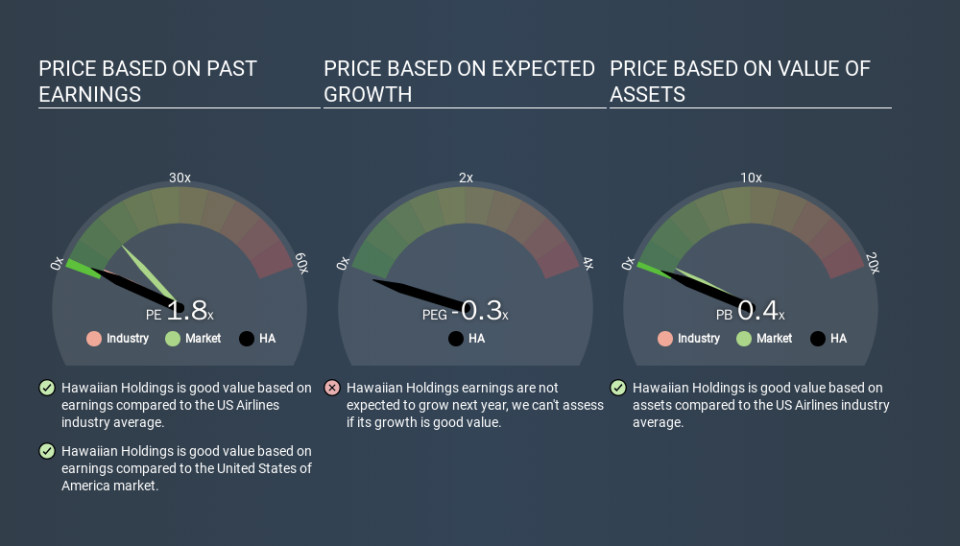A Sliding Share Price Has Us Looking At Hawaiian Holdings, Inc.'s (NASDAQ:HA) P/E Ratio

To the annoyance of some shareholders, Hawaiian Holdings (NASDAQ:HA) shares are down a considerable 68% in the last month. And that drop will have no doubt have some shareholders concerned that the 65% share price decline, over the last year, has turned them into bagholders. What is a bagholder? It is a shareholder who has suffered a bad loss, but continues to hold indefinitely, without questioning their reasons for holding, even as the losses grow greater.
Assuming nothing else has changed, a lower share price makes a stock more attractive to potential buyers. In the long term, share prices tend to follow earnings per share, but in the short term prices bounce around in response to short term factors (which are not always obvious). The implication here is that long term investors have an opportunity when expectations of a company are too low. One way to gauge market expectations of a stock is to look at its Price to Earnings Ratio (PE Ratio). Investors have optimistic expectations of companies with higher P/E ratios, compared to companies with lower P/E ratios.
Check out our latest analysis for Hawaiian Holdings
Does Hawaiian Holdings Have A Relatively High Or Low P/E For Its Industry?
We can tell from its P/E ratio of 1.83 that sentiment around Hawaiian Holdings isn't particularly high. If you look at the image below, you can see Hawaiian Holdings has a lower P/E than the average (2.8) in the airlines industry classification.
This suggests that market participants think Hawaiian Holdings will underperform other companies in its industry. Many investors like to buy stocks when the market is pessimistic about their prospects. You should delve deeper. I like to check if company insiders have been buying or selling.
How Growth Rates Impact P/E Ratios
P/E ratios primarily reflect market expectations around earnings growth rates. That's because companies that grow earnings per share quickly will rapidly increase the 'E' in the equation. That means even if the current P/E is high, it will reduce over time if the share price stays flat. Then, a lower P/E should attract more buyers, pushing the share price up.
Hawaiian Holdings had pretty flat EPS growth in the last year. But EPS is up 30% over the last 5 years.
A Limitation: P/E Ratios Ignore Debt and Cash In The Bank
The 'Price' in P/E reflects the market capitalization of the company. That means it doesn't take debt or cash into account. In theory, a company can lower its future P/E ratio by using cash or debt to invest in growth.
Spending on growth might be good or bad a few years later, but the point is that the P/E ratio does not account for the option (or lack thereof).
Is Debt Impacting Hawaiian Holdings's P/E?
Hawaiian Holdings has net cash of US$18m. That should lead to a higher P/E than if it did have debt, because its strong balance sheets gives it more options.
The Verdict On Hawaiian Holdings's P/E Ratio
Hawaiian Holdings has a P/E of 1.8. That's below the average in the US market, which is 12.2. Recent earnings growth wasn't bad. Also positive, the relatively strong balance sheet will allow for investment in growth. In contrast, the P/E indicates shareholders doubt that will happen! Given Hawaiian Holdings's P/E ratio has declined from 5.7 to 1.8 in the last month, we know for sure that the market is more worried about the business today, than it was back then. For those who prefer to invest with the flow of momentum, that might be a bad sign, but for deep value investors this stock might justify some research.
Investors should be looking to buy stocks that the market is wrong about. If it is underestimating a company, investors can make money by buying and holding the shares until the market corrects itself. So this free visualization of the analyst consensus on future earnings could help you make the right decision about whether to buy, sell, or hold.
Of course, you might find a fantastic investment by looking at a few good candidates. So take a peek at this free list of companies with modest (or no) debt, trading on a P/E below 20.
If you spot an error that warrants correction, please contact the editor at editorial-team@simplywallst.com. This article by Simply Wall St is general in nature. It does not constitute a recommendation to buy or sell any stock, and does not take account of your objectives, or your financial situation. Simply Wall St has no position in the stocks mentioned.
We aim to bring you long-term focused research analysis driven by fundamental data. Note that our analysis may not factor in the latest price-sensitive company announcements or qualitative material. Thank you for reading.

 Yahoo Finance
Yahoo Finance 
